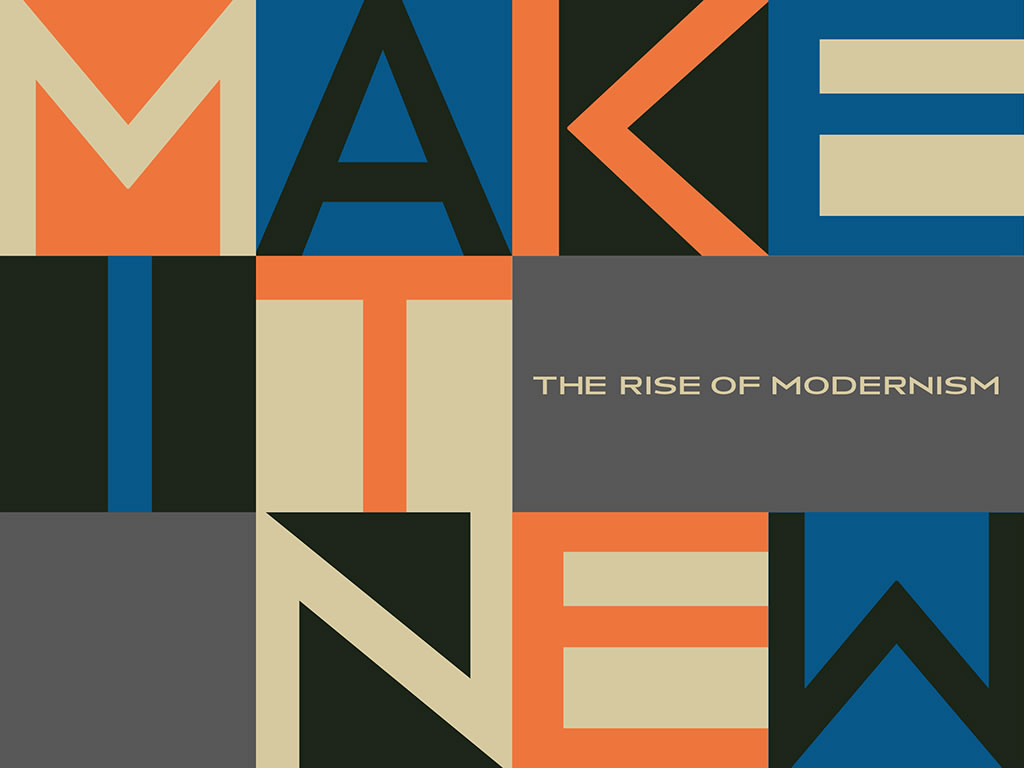Make It New
The Rise of Modernism
October 21, 2003 – March 7, 2004
The University of Texas at Austin's Harry Ransom Center will present a stunning array of more than 400 objects from the dominant and cultural movement of the 20th century in its exhibition, "Make It New: The Rise of Modernism."
The Ransom Center holds one of the richest and most diverse collections of Modernist art and literature in the world. "Make It New" offers a rare opportunity for students and the public to view the creations of this remarkable explosion in the arts and in ideas that helped reshape the vision of an entire century. Even our concept of the self was drastically altered; as Virginia Woolf wrote, around 1910 human character changed.
Modernism, which flourished from the 1890s to 1939, arose from a set of occurrences -- cultural, scientific and material -- that changed the nature of modern life. Modernism altered perceptions while capturing the imagination of patrons and publishers and worrying the stalwarts of the establishment. Some of its more flamboyant creations intrigued, frustrated, inspired and even enraged the public.
The Modernists reformed all of the arts -- architecture, dance, literature, music and painting -- by appropriating the great technological breakthroughs of the period into the fields of artistic endeavor and cultural production. While most exhibitions on Modernism have focused solely on literary or visual materials, "Make It New: The Rise of Modernism" presents a wider range of artistic creations, from musical scores and set design to mechanical inventions and the X-ray.
"As a movement, Modernism pushed the boundaries of what was artistically possible," said Ransom Center Director Thomas F. Staley. "This exhibition is an attempt not of definition, but of discovery and rediscovery of an artistic era that exploded with creativity and excitement."
"Make it new," Ezra Pound proclaimed. In this revolution, words were set free from syntax, notes from traditional harmonies and color and line from perspective. Dramatic works became musical and music became visual, and writings became sculptural.
Few institutions are better able to offer such a sweeping representation of Modernism as the Ransom Center. Since its founding in 1957, the Ransom Center responded to Modernism by collecting major texts, scores, manuscripts, art and objects from the movement. In turn, these collections helped define the institution's presence among major research libraries in America.
One of the foremost goals of the Center has been the acquisition, preservation and study of Modernist enterprises, particularly from the American, French and British traditions. It is especially appropriate that Ransom Center should host this interdisciplinary exhibition in the same year it is celebrating the completion of a major renovation.
Exhibition highlights include works that helped define Modernism, such as the annotated page proofs of James Joyce's "Ulysses," Frank Lloyd Wright's folios of architectural drawings and a corrected copy of T.S. Eliot's "The Waste Land." Additional works include Pablo Picasso's "Vénus du gaz," heavily corrected manuscripts of Marcel Proust's "Remembrance of Things Past" as well as art work by Juan Gris, Georges Braque and Max Ernst.
"Having lived most of our lives under the influence of Modernist art, we find it easy to forget its volatile origins, to overlook the remarkable strategies that the various groups and individual writers employed to bring their work to the forefront," said Staley. "Yet this distance allows us to see more clearly its remarkable breadth as well as its enduring influence."
Not presented in chronological order, Make It New is organized into thematic sections that reflect the period's rich diversity of ideas and expressions and enable viewers to better shape their understanding or version of Modernism: Portals of Discovery, Forms and Technologies, Invisible Worlds, The City and Marketing the New.
"This exhibition is not just another narrative that traces the history of Modernism, but rather an attempt to reveal Modernism in its myriad aspects," said Staley. "The exhibition exposes the kinds of textures, resonances and energies which made the first half of the 20th century so innovative that its art is still virtually synonymous with what 'newness' means," said Staley.
As a complement to the exhibition, the Ransom Center published a 160-page book, "Make It New: The Rise of Modernism," that contains 20 essays on Modernism commissioned for this volume. Twelve of the these are from authors and artists whose collections reside at the Ransom Center, including Julian Barnes, Penelope Lively, Russell Banks and Adrienne Kennedy. Also included in the book are essays by leading scholars in literature, art and music focusing on specific objects included in the exhibition.


